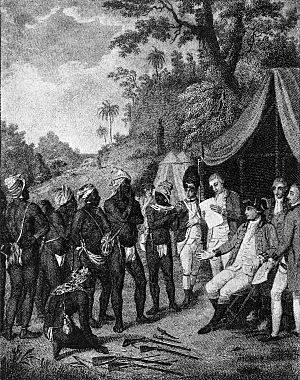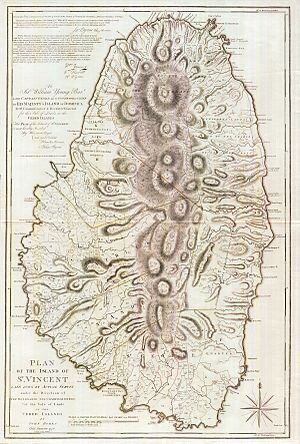Capture of Saint Vincent facts for kids
Quick facts for kids Capture of Saint Vincent |
|||||||
|---|---|---|---|---|---|---|---|
| Part of the American Revolutionary War | |||||||
|
|||||||
| Belligerents | |||||||
| Commanders and leaders | |||||||
| D'Estaing Trolong du Rumain Chatoyer |
Valentine Morris George Etherington |
||||||
| Strength | |||||||
| 1 frigate 2 corvettes 2 sloops 300–500 regulars and militia 800 local Black Caribs |
464 Royal American Regiment infantry (252 listed as fit for duty) | ||||||
| Casualties and losses | |||||||
| none reported 82 men lost by shipwreck |
2 merchant ships captured 422 men captured |
||||||
The Capture of Saint Vincent was a quick French invasion during the American Revolutionary War. It happened between June 16 and 18, 1779. A French force led by Charles-Marie de Trolong du Rumain landed on the island of Saint Vincent in the West Indies.
They quickly took control of the British-held parts of the island. Local Black Caribs, who lived in the northern part of the island, helped the French. The British Governor, Valentine Morris, and military leader, Lieutenant Colonel George Etherington, gave up without much fighting.
The French capture of the island meant the Black Caribs kept strong control over the northern areas. This control lasted until the Second Carib War in 1795.
Contents
Why Saint Vincent Was Captured
France Joins the War
In early 1778, France joined the American War of Independence. They became an ally of the American colonies. French Admiral Comte d'Estaing arrived in the West Indies with a large fleet of ships.
Around the same time, a British fleet also arrived. The British then captured the French island of St. Lucia. They used St. Lucia to keep an eye on the main French base at Martinique, where d'Estaing was located.
More British ships arrived in January 1779. Admiral John Byron took command of the British fleet. Over the next few months, both sides got more ships. Soon, the French fleet was a bit stronger than the British.
On June 6, Admiral Byron left St. Lucia. He was escorting British merchant ships to Europe. This left d'Estaing free to act. D'Estaing and Governor the marquis de Bouillé decided to attack nearby British islands. Their first target was Saint Vincent, just south of St. Lucia.
Tensions on Saint Vincent
The situation on Saint Vincent was tense. The island was split in half. One part was controlled by European settlers, mostly British planters. The other part was controlled by the local Black Carib people.
A treaty in 1773, after the First Carib War, set this dividing line. But neither side was happy with it. The British had to build outposts to protect their settlers.
Weak British Defenses
Saint Vincent's government and defenses were in a mess. Governor Valentine Morris took office in 1776. He reported that the island had almost no defenses. Besides problems with the Caribs, many British people on the island supported American independence.
The French captured Dominica in 1778. This led to arguments about emergency laws. So, the local assembly refused to give money for island defenses. Governor Morris even spent his own money to improve things.
The only British soldiers on the island were about 450 men. They were from the Royal American Regiment. Their commander was Lieutenant Colonel George Etherington. Most of these soldiers were poorly trained. About half of them were not even fit for duty.
Instead of training his troops, Etherington used many of them to clear land. This land was on an estate he owned on the Carib side of the island. The Caribs thought he got this land illegally. This made them very angry.
The French Governor de Bouillé had been in touch with the Caribs. He was giving them weapons. In late 1778, French officials met with Carib leader Joseph Chatoyer. Soon after, Governor Morris saw Caribs carrying new French muskets.
Who Fought?
French Forces
The French forces included:
- Soldiers from the Champagne Regiment
- Soldiers from the Viennois Regiment
- Two battalions from the Martinique Regiment
British Forces
The British forces included:
- About 400 men from the 60th (Royal American) Regiment of Foot
The Capture of the Island
Admiral d'Estaing put together a force of 300 to 500 soldiers. These included French regular troops and about 200 volunteers from Martinique. The invasion force was led by Charles Marie de Trolong du Rumain. He had recently captured British-controlled Saint Martin.
The force sailed on a fleet of ships. It included a frigate called Lively, two corvettes, and two privateer ships. Du Rumain left Martinique on June 9 and reached Saint Vincent on June 16. One of his privateers was wrecked, and 82 men were lost.
Two French ships anchored near Calliaqua. A third anchored off Kingstown. The ships did not fly any flags. This made people wonder who they were. Local planters thought they were merchant ships coming for the sugar harvest. They stopped a guard from firing a warning cannon. One man sent to check on the ships was captured.
As the French began landing troops, a small group landed on the eastern shore. Their job was to get the Caribs to join them. About 800 Caribs quickly joined the French. They attacked British settlements near the border. Meanwhile, du Rumain led his main troops towards Kingstown.
The alarm was finally raised. Governor Morris thought they could fight the French in the hills above Kingstown. He hoped the British navy would come to help. But Lieutenant Colonel Etherington disagreed. He especially worried about the large number of Caribs joining the attack.
A flag of truce was sent to the French. Du Rumain demanded that the British surrender completely. Morris refused at first. During the talks, three ships with British flags were seen. Du Rumain went back to his ship and realized they were supply ships. He captured two of them, but the third got away. After more talks, the British agreed to surrender. The terms were similar to those given when Dominica was captured in 1778.
What Happened Next
After du Rumain's success, d'Estaing sailed with his entire fleet towards Barbados. But strong winds made it hard to get there. So, he changed his plan and sailed for Grenada. He captured Grenada on July 5.
Admiral Byron learned about the capture of Saint Vincent on July 1. He was getting ready to take it back when he heard about the attack on Grenada. He immediately sailed there. The fleets fought off Grenada, and d'Estaing won.
Both Grenada and Saint Vincent stayed in French hands until the war ended. They were given back to Britain in 1783 as part of the Treaty of Paris.
Attempt to Recapture Saint Vincent
Admiral George Brydges Rodney tried to get Saint Vincent back in December 1780. He arrived in the Caribbean after one of the worst hurricane seasons ever. Rodney heard rumors that Saint Vincent's defenses were destroyed by a hurricane in October.
He sailed to Saint Vincent with ten ships and 250 soldiers. Although Kingstown had a lot of damage, the defenses above the town were in good shape. About 1,000 French and Carib soldiers defended them. The British troops landed, but they found it very difficult to move. They were re-embarked after only one day.
Aftermath for Leaders
Lieutenant Colonel Etherington faced an investigation in 1781 about his actions during the invasion. He was found innocent. Governor Morris also asked for an investigation into his behavior. He felt his actions were misunderstood. He was also cleared of wrongdoing.
Morris never returned to the island. He died in England in 1789. He had spent seven years in prison because of financial difficulties. Some of these debts were from spending his own money on Saint Vincent's defenses.
Caribs and the Future
The Black Caribs often bothered British settlers during the French control. Sometimes, the French military had to step in to stop fighting. After the island returned to British control, there was an uneasy peace.
In the 1790s, the Caribs rose up again in the Second Carib War. This was part of French efforts to spread their revolution. The British then sent the Caribs away to Roatán. This is an island off the coast of present-day Honduras. Their descendants are now known as the Garifuna people.
Saint Vincent and the Grenadines became independent from Britain in 1979.
|



